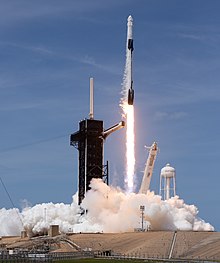
Back Falcon 9 AN فالكون 9 Arabic Falcon 9 Azerbaijani فالکون ۹ AZB Falcon 9 Byelorussian Фалкън-9 Bulgarian ফ্যালকন ৯ Bengali/Bangla Falcon 9 Catalan فاڵکۆن ٩ CKB Falcon 9 Czech
 | |
 | |
| Function | Orbital launch vehicle |
|---|---|
| Manufacturer | SpaceX |
| Country of origin | United States |
| Cost per launch | US$67 million (2022)[1] |
| Size | |
| Height | |
| Diameter | 3.7 m (12 ft)[2] |
| Mass | |
| Stages | 2 |
| Capacity | |
| Payload to low Earth orbit (LEO) | |
| Orbital inclination | 28.5° |
| Mass | |
| Payload to Geosynchronous transfer orbit (GTO) | |
| Orbital inclination | 27.0° |
| Mass | |
| Payload to Mars transfer orbit | |
| Mass | FT: 4,020 kg (8,860 lb)[1] |
| Associated rockets | |
| Derivative work | Falcon Heavy |
| Launch history | |
| Status |
|
| Launch sites |
|
| Total launches |
|
| Success(es) |
|
| Failure(s) | 1 (v1.1: CRS-7 in-flight) |
| Partial failure(s) | 1 (v1.0: CRS-1)[8] |
| Notable outcome(s) | 1 (FT: AMOS-6 pre-flight destruction) |
| Landings | 286 / 295 attempts |
| First flight |
|
| Last flight |
|
| First stage | |
| Powered by | |
| Maximum thrust | |
| Specific impulse | |
| Burn time | |
| Propellant | LOX / RP-1 |
| Second stage | |
| Powered by |
|
| Maximum thrust | |
| Specific impulse | |
| Burn time | |
| Propellant | LOX / RP-1 |
Falcon 9 is a partially reusable medium-lift launch vehicle that can carry cargo and crew into Earth orbit,[A] designed, manufactured and launched by American aerospace company SpaceX. It can also be used as an expendable heavy-lift launch vehicle.[B] The first Falcon 9 launch was on 4 June 2010. The first Falcon 9 commercial resupply mission to the International Space Station (ISS) launched on 8 October 2012.[17] In 2020 it became the first commercial rocket to launch humans to orbit and remains the only such vehicle.[18] It is the only U.S. rocket certified for transporting humans to the ISS.[19][20][21] In 2022, it became the U.S. rocket with the most launches in history and with the best safety record, having suffered just one flight failure.[22]
The rocket has two stages. The first (booster) stage carries the second stage and payload to a pre-determined speed and altitude, after which the second stage accelerates the payload to its target orbit. The booster is capable of landing vertically to facilitate reuse. This feat was first achieved on flight 20 in December 2015. As of 28 April 2024, SpaceX has successfully landed Falcon 9 boosters 286 times.[C] Individual boosters have flown as many as 20 flights.[23] Both stages are powered by SpaceX Merlin engines,[D] using cryogenic liquid oxygen and rocket-grade kerosene (RP-1) as propellants.[24][25]
The heaviest payloads flown to geostationary transfer orbit (GTO) were Intelsat 35e carrying 6,761 kg (14,905 lb), and Telstar 19V with 7,075 kg (15,598 lb). The former was launched into an advantageous super-synchronous transfer orbit,[26] while the latter went into a lower-energy GTO, with an apogee well below the geostationary altitude.[27] On 24 January 2021, Falcon 9 set a record for the most satellites launched by a single rocket, carrying 143 into orbit.[28]
Falcon 9 is human-rated for transporting NASA astronauts to the ISS. Falcon 9 is certified for the National Security Space Launch[29] program and NASA Launch Services Program as "Category 3", which can launch the most expensive, important, and complex NASA missions.[30]
Several versions of Falcon 9 have been built and flown: v1.0 flew from 2010 to 2013, v1.1 flew from 2013 to 2016, while v1.2 Full Thrust first launched in 2015, encompassing the Block 5 variant, which has been in operation since May 2018.
- ^ a b c d Cite error: The named reference
spacex-capabilitieswas invoked but never defined (see the help page). - ^ a b c d e f g h i j Cite error: The named reference
falcon9-2015was invoked but never defined (see the help page). - ^ a b c d e f g h i Cite error: The named reference
falcon9-2013was invoked but never defined (see the help page). - ^ a b c d e f g h i Cite error: The named reference
falcon9-2010was invoked but never defined (see the help page). - ^ "Due to continued design improvements, this Falcon 9 carried its highest ever payload of 17.5 tons of useful load to a useful orbit". X (formerly Twitter).
- ^ Clark, Stephen (17 December 2018). "Air Force requirements will keep SpaceX from landing Falcon 9 booster after GPS launch". Spaceflight Now. Archived from the original on 20 May 2019. Retrieved 17 May 2019.
- ^ Seemangal, Robin (4 May 2018). "SpaceX Test-Fires New Falcon 9 Block 5 Rocket Ahead of Maiden Flight (Updated)". Popular Mechanics. Archived from the original on 7 April 2019. Retrieved 2 February 2019.
- ^ de Selding, Peter B. (15 October 2012). "Orbcomm Craft Launched by Falcon 9 Falls out of Orbit". Space News. Archived from the original on 12 May 2015. Retrieved 15 October 2012.
Orbcomm requested that SpaceX carry one of their small satellites (weighing a few hundred pounds, versus Dragon at over 12,000 pounds)... The higher the orbit, the more test data [Orbcomm] can gather, so they requested that we attempt to restart and raise altitude. NASA agreed to allow that, but only on condition that there be substantial propellant reserves, since the orbit would be close to the International Space Station. It is important to appreciate that Orbcomm understood from the beginning that the orbit-raising maneuver was tentative. They accepted that there was a high risk of their satellite remaining at the Dragon insertion orbit...
- ^ Graham, William (21 December 2015). "SpaceX returns to flight with OG2, nails historic core return". NASASpaceFlight. Archived from the original on 22 December 2015. Retrieved 22 December 2015.
The launch also marked the first flight of the Falcon 9 Full Thrust, internally known only as the "Upgraded Falcon 9"
- ^ Graham, Will (29 September 2013). "SpaceX successfully launches debut Falcon 9 v1.1". NASASpaceFlight. Archived from the original on 29 September 2013. Retrieved 29 September 2013.
- ^ Cite error: The named reference
MSDBwas invoked but never defined (see the help page). - ^ Cite error: The named reference
falcon9-2016was invoked but never defined (see the help page). - ^ a b "Falcon 9". SpaceX. 16 November 2012. Archived from the original on 1 May 2013. Retrieved 29 September 2013.
- ^ Cite error: The named reference
SpaceX March 10, 2009was invoked but never defined (see the help page). - ^ Stephen Clark (24 November 2021). "NASA spacecraft blasts off on experimental mission to divert asteroid". Spaceflight Now.
A second burn, lasting nearly a minute, started 28 minutes after liftoff to accelerate DART to a speed of more than 24,000 mph (39,000 kilometers per hour), placing DART on a trajectory to escape the trip of Earth's gravity.
- ^ Trevor Sesnic (15 November 2021). "DART (Double Asteroid Redirection Test) | Falcon 9 Block 5". Everyday Astronaut.
initial orbit: heliocentric
- ^ Amos, Jonathan (8 October 2012). "SpaceX lifts off with ISS cargo". BBC News. Archived from the original on 20 November 2018. Retrieved 3 June 2018.
- ^ "NASA and SpaceX launch astronauts into new era of private spaceflight". 30 May 2020. Archived from the original on 12 December 2020. Retrieved 8 December 2020.
- ^ Cawley, James (10 November 2020). "NASA and SpaceX Complete Certification of First Human-Rated Commercial Space System". NASA. Archived from the original on 24 February 2021. Retrieved 10 November 2020.
- ^ Berger, Eric (22 April 2020). "The Falcon 9 just became America's workhorse rocket". Arstechnica. Archived from the original on 23 April 2020. Retrieved 22 April 2020.
- ^ Wall, Mike (4 June 2020). "Happy birthday, Falcon 9! SpaceX's workhorse rocket debuted 10 years ago today". Space.com. Archived from the original on 4 June 2020. Retrieved 4 June 2020.
- ^ Berger, Eric (3 February 2022). "The Falcon 9 may now be the safest rocket ever launched". Ars Technica. Archived from the original on 25 April 2023. Retrieved 21 May 2023.
- ^ "SpaceX launches Falcon 9 first-stage booster on record-breaking 19th flight". Spaceflight Now. 23 December 2023.
- ^ Malik, Tariq (19 January 2017). "These SpaceX Rocket Landing Photos Are Simply Jaw-Dropping". Space.com. Archived from the original on 20 June 2019. Retrieved 20 June 2019.
- ^ Thomas, Rachael L. "SpaceX's rockets and spacecraft have really cool names. But what do they mean?". Florida Today. Archived from the original on 25 June 2019. Retrieved 20 June 2019.
- ^ Todd, David (6 July 2017). "Intelsat 35e is launched into advantageous super-synchronous transfer orbit by Falcon 9". Seradata. Archived from the original on 28 July 2020. Retrieved 28 July 2020.
- ^ Kyle, Ed (23 July 2018). "2018 Space Launch Report". Space Launch Report. Archived from the original on 23 July 2018. Retrieved 23 July 2018.
07/22/18 Falcon 9 v1.2 F9-59 Telstar 19V 7.075 CC 40 GTO-
{{cite web}}: CS1 maint: unfit URL (link) - ^ Wattles, Jackie (24 January 2021). "SpaceX launches 143 satellites on one rocket in record-setting mission". CNN. Archived from the original on 24 January 2021. Retrieved 24 January 2021.
- ^ Kucinski, William. "All four NSSL launch vehicle developers say they'll be ready in 2021". Sae Mobilus. Archived from the original on 29 October 2019. Retrieved 29 October 2019.
- ^ Wall, Mike (9 November 2018). "SpaceX's Falcon 9 Rocket Certified to Launch NASA's Most Precious Science Missions". Space.com. Archived from the original on 29 October 2019. Retrieved 29 October 2019.
Cite error: There are <ref group=upper-alpha> tags or {{efn-ua}} templates on this page, but the references will not show without a {{reflist|group=upper-alpha}} template or {{notelist-ua}} template (see the help page).
© MMXXIII Rich X Search. We shall prevail. All rights reserved. Rich X Search